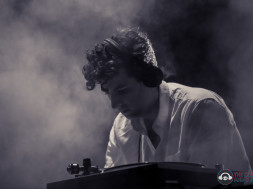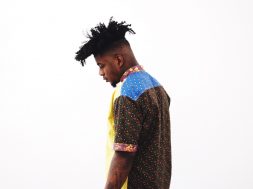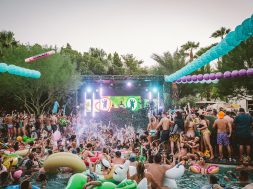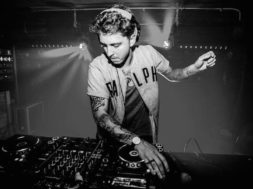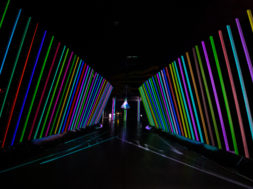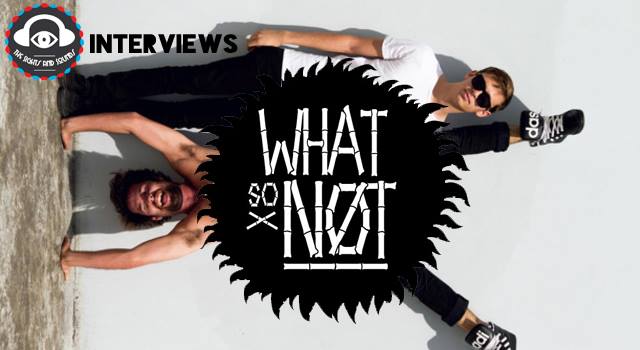![[INTERVIEWS] Emoh Instead of What So Not](https://thesightsandsounds.com/wp-content/uploads/2015/01/10937321_10102357686434450_435105048_n.jpg)
[INTERVIEWS] Emoh Instead of What So Not
Late last year, prior to the first What So Not London show we caught up with the incredibly charming and incredibly talented Chris Emerson a.k.a Emoh Instead, one half of Australian dance powerhouse What So Not. Over the course of thirty minutes we discussed history, culture, the Mothership tour, the Emoh Instead project, the dance music boom in Australia, the creative process behind the What So Not project and the brotherly love between himself and his What So Not collaborator – the mercurial, Flume.
Engorge on 30-minutes worth of enlightening conversation in its unadulterated, transcripted glory:
Sights and Sounds (S+S): So, first place I want to start, on a lighthearted note…
What So Not (WSN): Yep…
S+S: Busy summer…Mad Decent Block Party and the Mothership Tour, who partied harder?
WSN: Ummm…really funny actually. I was on the Mothership tour and I had met Dillon [Francis] in Australia and he was partying really really hard. And then on the Mothership tour no one really partied, everyone stayed up late, but they didn’t really party. It was quite an interesting experience for me as it was the first time I went on a bus tour. You know, I assume there are a lot of people out there who haven’t been on bus tours, and I was one of those people. It’s quite interesting – you go to the show, you have catering, you have sound check, you all go sit in your rooms and write music together and hang out and throw food at each other or whatever, and then you do the show, and you watch other people play, maybe go chill out and then everyone just hangs out and has a couple of drinks. Shit might finish at midnight, everyone is packing down, and everyone is relaxing and then head to the bus at 3am and go to sleep. Then you wake up in a brand new city and you don’t even realize that you’ve moved. It’s like a time capsule those things. The door is shut, the air con is on quite loud, so you don’t hear the bus moving, and you don’t hear traffic. It’s pitch black and you open your curtains and there are twelve people behind you in these capsules. And then you open door and you walk out in this new city and there’s catering, you get your food, be like “hey guys do you want to go for a run, get some exercise?” So you do some running around the block a few times, come back, have a shower and then same thing…you write some music and get ready for your set. And that’s it every single day. It was such an amazing experience. In comparison, flying everywhere to all these different places is horrible. It’s so horrible compared to the bus tour. I mean it’s something that has such big overheads in comparison but how was that Trav…
Travis (What So Not’s Tour manager): I prefer it. Any day of the week I’ll take a bus…
WSN: You know, with regular touring you get four or five hours sleep. Sometimes one, sometimes you don’t sleep and then you go and get up at 6 or 7am after going to bed at 5am, you go to the airport, you check in after standing in a very long line, you go sit, eat some food, get on the plane, conk out for two hours, wake up, work on a song, go to the hotel, do some press, do some emails and maybe have another hour nap, go to dinner, go to show and then repeat…you know…
S+S: Go again?
WSN: Yeah
[youtube http://www.youtube.com/watch?v=KB6ac_hRBik&w=560&h=315]
S+S: So this is What So Not’s first time in Europe, therefore how’s all the flying been?
WSN: You know Europe’s not so bad, America maybe. It’s funny when you go to a new territory and you are breaking in, you don’t have much of a say of where you go or what you do. You have an opportunity here, you need to take it and I don’t care if you get one hour sleep and that’s really hard as you have to fly around from East coast to West coast, which is a 6 hour flight and a 3 hour time difference so you are losing 9 hours of your day. Europe has been great, because we have been jumping on trains and no passports and yeah there were only a couple of flights here and there and we have had time off to see Amsterdam, Berlin and London, just hanging out and seeing friends here and jumping into the studio. I worked with GANZ in Holland, then George Maple and this guy Royce who is a producer. Even like the Snakehips guys are coming down tonight. So, yeah it’s been really cool meeting all these people who I have met across the world and never been in their home territory.
S+S: How have the shows been?
WSN: Incredible. It’s funny I was talking to my agent and neither of us couldn’t believe how well it all went on this first trip. I didn’t even see the stats for the tour, the venue capacities…the amount of shows until later in the piece. I thought we would do a couple of 200-, 300-head venues and it would be alright and there would be some people excited about what we are doing. But you know the first couple of shows…the second show we did was the Nordic Impact Festival in France and there were 3000 people just going insane. And I was like “whoa is this happening in Europe”. I didn’t expect that. And Europe traditionally is into House and Techno and more four to the floor kind of stuff. And things were going amazingly well for us in America this year and in Australia, and coming here I thought it may not be something people are into but it seems to be very much not the case, and the response has just been insane. So we did shows like that, and then shows in Hungary where we played a show to 1000 heads on a boat and then like in Belgium, and Cologne and Barcelona. [To Travis] And what was that other festival we did…
Travis: CATCH?
WSN: Yeah, CATCH, with Hudson Mohawke and Kaytranda and that was amazing. That was such an insane venue. It was in this giant convention centre with all these different rooms and I played in this huge theatre. Yeah it was really great. I have been loving it here. I think I was saying in another interview that for example the footpath has more history than my whole country, in terms of when it was colonized, while this has probably been here for a few hundred years, these little stone pebble walkways. It’s such a different realm here and it’s been so exciting and so great to draw from to write music and things like that. Just the history and the culture – you walk across this bridge and there are these iron crafted handle with this gargoyle standing on the shoulder of it, and all these patterns and acrylic and you don’t see things like this in Australia…like it’s a really nice place but we don’t have history like that. We don’t have history embedded into every manmade structure.
S+S: So talking about history and culture and it being quite important and formative in the creative process, and as we are in London and the UK, let’s talk about UK dance culture. You mentioned before Rustie and Jon Hopkins as key influences, what is about someone like Jon and his music?
WSN: I think where we have come from is very different to that realm and both Harvey and I heard that album that he did and I though it was quite new but it’s probably quite old… probably like a year and a half old…
S+S: Immunity?
WSN: Yeah, Immunity…How old is that now?
S+S: Errrrm early 2013? [Correct answer: June 2013]
WSN: So I’m very out of date. And it’s out of my realm. But when I heard that and I first started going clubbing, I would go to minimal techno parties, and I loved it but I didn’t know anything about it and I didn’t know any of the songs playing and I moved into other fields of music. And for me, it’s such a different form of music; it’s all about progression and this slow release and gain of sounds, and volume and density and tone. It’s like a whole piece of music rather than a song, and it’s growth and progression. Sometimes there is not even a chord in a song, but just percussion or just sounds and it seems to be this rolling organic movement that is constantly changing. It’s not like chorus, verse in a pop song it’s something completely different. And I think, from my vague understanding of this culture I have seen over here, in the short space of time, that this is something embedded within the music scene and is something people have grown up with. For me it is very different, and I am very intrigued by things I am seeing and hearing.
S+S: On your travels have you crossed paths with Jon or caught him live?
WSN: No, unfortunately not.
S+S: If you ever get the chance…
WSN: Amazing?
S+S: Crazy. He sets up three Kaoss pads and controls the visuals and the beats, and colour balloons, and if you wear glasses, don’t go to the front or you’ll get one to the face
WSN: Oh really…[Laughs]
S+S: Actually then talking about live shows, what’s the live set up at a What So Not live show?
WSN: Where I come from there are a lot of bands, and if you’re in a band you are a live act and if you’re not in a band then you are probably a DJ. However here in Europe there are people making these electronic solo bands and using multiple instruments and things. And I hear that and I’m like “Dam, I need to step up my game”. But, I have DJed for a long time, since I was 17/18 and I am really passionate about that. I started on CDJs and then I bought turntables because I wanted to be able to do vinyl. But then I went back to CDJs. I probably could go to something else, like I could go to some kind of MIDI controlled live set, but I do like the freedom of DJing. I like that you can have 20,000 songs and would not have had to pre-meditatively warped and captured the scene so it fits into your Ableton set. I like the idea that you can just play. I love setting up a whole load of Hot Cue banks and when I play I use four decks. And rather than playing song by song, I try and do layers of music. So I’ll have a beat on one deck, I’ll have a Capella samples on another deck and then I’ll have a What So Not song and then the hook of something. So for example with Prodigy “Breathe”, we take that hook and then we have a groove going and cut it and then play just that hook and then bring an a capella in on top and then start mixing in a different track all at the same time. And it sorta becomes something that people, although they may have heard that song, they would not have heard it in that way. And it becomes something exciting, as they may be like “cool, I know that song, so it’s interesting to me, but I haven’t heard it done like this”. And what I like to do in a club setting is play off…wait I’ll just stop there…but something that is so hard and so exciting about being in this different place in Europe is that I don’t know what people have grown up on. I don’t know their pop culture references. And that’s something I like, to get into a city, to talk to DJs, to talk to regular people, to talk to promoters and get an idea of where everybody is at. And I had a big culture shock the first time I went to Asia, as I had been playing in Australia for the past 5 or 6 years and I knew crowds like THAT. I just knew what they wanted, how they wanted it and I knew what they grew up and a really cool movie that was out at the time and if I played a riff from the movie they would go crazy to it. But in Asia, I kind of had no idea what they wanted, and as a DJ I think it’s important to know what people want and then how to give it to them in a really interesting way.
[youtube http://www.youtube.com/watch?v=0jL6WBs1_lI&w=560&h=315]
S+S: With your experience of culture shock, has that influenced the way you build sets, or made you think “Oh, I’m not going to go for that again?”
WSN: When you are doing such a large area like Europe for first time, you really have to test the waters. Like, one of the first shows I did, I played a bit of house music, and I normally play house music in my set. But it’s funny, because I thought that was what everyone would react to but I think because everyone is so knowledgeable of that over here and so used to that over here, it dipped out a little bit. And I was like “Woah…Ok” and I thought that was the direction I was going to have to take the What So Not sets across here in Europe because that’s what people like and it’s what they are used to. But I found it has been the opposite, I actually found they like the weird, harder or softer beatsy kind of music that I thought would be more appealing to an American crowd. But on the flipside, you go to America and you play American house music and they go off to it, and they’re like “what is this? I have never heard this before”. There all these different layers to it, like when I was doing all these shows in America at all these EDM events you see loads of people with their hands in the air, like monotonous screaming and yelling all the lyrics to every song and I realised if your entire set is full of people waving their hands and screaming every lyric to every song, you are probably doing a really bad job, as you are probably just playing what everyone else is playing. You are probably not doing anything interesting, unless of course they are your own songs, then congrats to you for having sixty minutes of hits. But, it was such an eye opener and it was very counter to what I had seen or what I had been told as a DJ, that you need to get a reaction from people. Sometimes the reaction is them standing still, really taking a moment to think, “Oh wow, I haven’t heard this before, this is really cool”. And then they just watch you. You know, it’s more like a show. You go to a show, you watch someone, and you clap at the end and things like that. Like when you clap at the end of song for a band and you dance around a little bit and not go crazy because you don’t know the song. And I think it’s important for DJs maybe to not be scared of people not reacting to something… it doesn’t mean that they don’t like it. I had a really strong experience of that on the Skrillex tour. Because you know, he’s probably one of the biggest acts in the world and What So Not at the moment is “cool” and is doing “cool shows” but I’m not at that level. I’m nowhere near it. And I would do a show supporting him and people would have no idea who I am or what my music is and they would have no idea how to dance to it. And they would just like stand there sometimes but then I would watch Sonny from the crowd later in the day and people would come up and say “Oh my God dude, I’ve never heard that music before, I absolutely loved it” and I would be like “Really?” So when people stand there and just look and dance a little bit, it doesn’t mean they don’t like it, but maybe they just haven’t heard it before or maybe it’s a bit different.
S+S: Do you think that’s better because it’s more of an active process, in the sense the artist gives the audience something and the audience gives something back…
WSN: Totally…
S+S: Rather than hear all the hits…
WSN: Exactly! I mean it’s a balance. And that’s where culture comes into to it. You need to know what is a hit for them, and you can either play a hit or what resembles a hit or takes influence from a hit, so you can keep them interested through those troughs of throwing things at them that are too strange. But maybe they might just go home and talk about that moment where it was too strange and you have to kind of balance it out. Everyone in the audience is going to be different and you have to think what way can I bring my taste and my message to them without scaring them and making sure they stay interested and stay involved in this collective moment with everyone here at this event.
[youtube http://www.youtube.com/watch?v=x8SO2BwNg4k&w=560&h=315]
S+S: Moving on a tiny bit, you actually mentioned it when we were talking about giving people music they haven’t’ heard. I think I read a quote…this is going to sound so lame…but I think I read a quote by an executive at Sony Music Australia who said the Australian sound within dance music is unlike anything people had heard. And with that Australian scene, why do you think its unlike anything people have heard? Is that a cultural thing, or a shared influence thing…?
WSN: It’s probably a couple of things. I think the biggest thing in Australia is isolation. We are so far from everything else. There are lots of different types of people in Australia, but a lot of the friends I have, have this thirst to escape that place down there. They love it and it’s great to come home to but they want to do something more – they want to go see New York, they want to go see London, they want to go to Amsterdam. They want to see the world. They want to get out there. It’s this thirst to find things, research things and look into things. Possibly in other cultures it’s taken for granted, it’s like “Oh look at this amazing history here”. You see it every day and become numb to it because it’s the norm and we don’t have things like that so it kind of drives you to find it. I think as well that the isolation has a big influence on getting out of Australia, and if you want to be big overseas you have to be really fucking good. You have to know what you are doing, you have to work out a good team, you have to work out a good plan and because first off it’s 2000 AUD dollars to get a flight anywhere from Australia…
S+S: and 22 hours!
WSN: As a broke arse band that’s a lot of money so yeah there’s this drive to be as good as anyone else in the world, so you even get the chance to go somewhere else in the world and start to build something there.
S+S: So with the boom of Australian bedroom producers, it sounds like you find it more inspiring rather than suffocating…is that right?
WSN: Yeah totally! I think with this wave of bedroom producers, I would have to honestly say we should contribute that a lot to Harley [Streten] and his work with the Flume project. Essentially that project took over mainstream dance culture in the entire country. And you had 12-15-year old kids instead of writing a cheesy electro house song, they were writing weird moody beats music. And it was this huge shift that those groups of kids are now hitting 18, they are now playing venues, they are now developing live shows and they are all sort of flourishing and coming into this dance world. And I think it’s just a roll on effect from what was introduced and imposed on them, in a positive manner, when they were younger and it’s now coming to the age where they maybe start their own music project or their own business. It’s all sort of flourishing out of that.
[youtube http://www.youtube.com/watch?v=8ATu1BiOPZA&w=560&h=315]
S+S: And when you make music with Harley, how does it work? Do you go to the studio? Do you bring a few ideas and he brings a few ideas, and then it comes together that way?
WSN: It’s an ever-evolving process that has changed a number of times since the start to now. When we started working together, I had never even used a synth. I had used Ableton and done a lot of drum programming, because I played drums for 10 years. But, I had not written a song per se. And Harley at the time had been writing in his bedroom for six years, and was doing remixes for Ministry of Sound and things like that, but he wasn’t yet playing venues and doing shows or anything. He sort of taught me all about production in the early days and just how to write a song, how to do chords, what works, what doesn’t and how to progress a song and do fills. And over the next couple of years, especially when he started touring after he brought out his Flume album, it was this time where I had to really step it up. I spent a year/year and a half intensely working every single day so I could catch up on those six years. Essentially, I wanted to put out music on a level that Harley could, so the What So Not project was still the What So Not project. Across that time Harley was travelling, and he would shoot me ideas and we would essentially start remixing each other’s songs. When we first started I would go round his house and we would just work in his bedroom a couple of days a week and then just go surfing and hang out. And then when his album came out, he started touring all round the world, we’d start sending each other parts and remixing each other’s ideas. And then when we were in the same country again, we would come together and nut everything out and make all these quick decisions. I find it, and so does he, so hard on Skype to come to like a decision when we are both “I want it like this”. It’s always that middle ground where we end up and I think that’s what makes What So Not what it is
S+S: I think you said in an interview, you guys fight like brothers?
WSN: Yes, we definitely fight like brothers. And I think that is one of the most positive things for the creative output of the project.
S+S: And when you make music under the moniker Emoh Instead do you have a different headspace? Like when you did the Touch Sensitive remix for example…
WSN: With that project, I have complete freedom, to do whatever I want, whatever I am feeling to put it out whenever I like. The What So Not project is a partnership and is part of this bigger machine that has managers and agents all round the world. It has press. You can’t just do something because you want to do it. You do something that you really like, then I will work on it with Harley, we’d come to a middle ground then we would speak to everyone else and they will be like “alright, let’s get creative with this, let’s get some really cool video we can put with this and then some imagery we can put into the visual for the show”. You see its part of this big picture. Whereas the Emoh project has this complete freedom. Really for me that project is what I used to do – travel around Australia and play club shows in front of awesome people and just put out music when I feel like it. That’s the difference with the projects.
S+S: In terms of Australian dance music, a lot of people know of Flume and his influence, but what is your opinion regarding the importance and influence of someone like Michael Di Francesco a.k.a Touch Sensitive and the stuff he did with The Van She?
WSN: There was this wave back in 2006/2007, and it was really peaking then especially with the Bang Gang DJs in Australia. I don’t know if you’re familiar with them here but they were friends with a lot of the French DJs and a lot of the international guys. They were incredible – an incredible group of creatives that would run these crazy stupid parties. They had their own fashion label and their own record label and they were just geniuses in terms of art. So it was them and the whole sort of Diplo/MIA sound coming out around then. And grouped into them was of course Van She. They were part of the Modular crew and that wave had such a big impact on everyone in Australia. And it had the same impact that Harley had on this generation. That era was the reason why me and Harley were into music. And when Harley did the Flume project and we did the What So Not project that is the reason why all these new kids are into it. And it’s almost like this wave that comes up and then starts to dip down, and five or six years may pass and then it will come up again. It’s this roll on effect. And Mike of course was part of that, he was in Van She, which was such a major influence in that era, and now he’s doing Touch Sensitive. And he’s also a band member in this act George Maple, which is another Future Classic act, which is also doing some really cool things. And it’s really cool that people like Mike, who are such talented musicians, it doesn’t matter where the scene goes, they are always one step ahead creating pieces of work, which are fitting into whatever has just happened.
[youtube http://www.youtube.com/watch?v=5OaanwN1vFQ&w=560&h=315]
59

